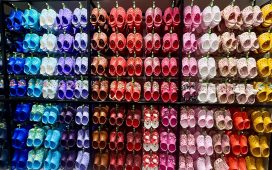Consumers await after U.S. President Donald Trump announced tariffs on goods imported to the U.S. … More
As President Donald Trump continues to extol the need to “take the medicine” rather than de-escalating imminent trade tariffs, the argument over who will ultimately pay the price continues to rage.
Like it or not, almost every country around the world has deeply entwined supply chains, with products created from multiple sources and assembled at factories from Bangladesh to Baltimore. That means that tariffs will almost certainly push prices up on almost all goods consumers take for granted, from a cup of coffee to main street apparel.
And there are further concerns that the American consumer was in nowhere as robust a financial position as Wall Street has assumed, with retailers including market leader Walmart lining up at their most recent results to warn over the prospects in 2025.
Yet as many analysts ignored retail’s role as the canary in the mine shaft, now those hard-pressed shoppers are facing a wipe out in their assets, with anyone owning shares, property or even crypto facing a meltdown, at least in the short term.
And it’s those wealthier consumers who have driven the U.S. economy, shopping with enthusiasm come hell or high water.
So what American favorites are most at risk from immediate price hikes? Here are six popular categories that will be hit by price spikes.
Your Morning Cup Of Coffee
Almost all of the coffee drunk in the U.S. comes from outside the country, mostly Brazil and Colombia, which are subject to the baseline 10% tariffs. Vietnam is also a major exporter of some varieties. Popular foods from European Union countries, which have been hit by a 20% tariff, such as olive oil, primarily from Spain, Italy and Greece, could also hike in price at the grocery store.
Consumer Electronics
China, Taiwan and South Korea are all top exporters of electronics to the U.S., including cell phones, gaming consoles and TVs. Almost all iPhones are made in China, though some are also made in India which has also seen a 26% tariff imposed. Japanese video gaming giant Nintendo announced Friday that it was delaying pre-orders of its Switch 2 console, citing the need to “assess the potential impact of tariffs.”
Everyday Apparel
The apparel mega-hubs of Vietnam, China and Bangladesh have been the world’s engine room of fashion manufacturing, supplying many U.S. main street and mall retailers. The three are all among the top five largest apparel exporters to the U.S. and that means price hikes across the fashion sector.
Two examples of those exposed to the tariffs are The Gap Corp., which is estimated to source about one fifth of its merchandise from Vietnam alone, while over a third comes from India, Indonesia and Bangladesh, plus Swedish retail giant H&M, which manufactures most of its apparel in China and Bangladesh.
In times of hardship, Americans often turn to affordable clothing options such as Target and Walmart, but the latter has also raised red flags over pricing and profits in 2025, so there may be no refuge, particularly for lower-income households, the U.S. Fashion Industry Association warned in a statement last week.
Sneakers
Footwear and sneakers, including big favorites from Nike and Adidas, could become more expensive. Both sportswear brands source heavily on Asian factory hubs, with about half of Nike and 39% of Adidas sneakers made in Vietnam. In 2024, the U.S. imported more than $27 billion of footwear, mostly from China and Vietnam, which was subject to tariffs of about $3 billion. Now, that tax levy could nearly triple and store prices could rise by 10% to 12% to offset the duties.
Fast Fashion Deliveries
On top of tariffs, President Trump signed an executive order ended the so-called de minimis loophole that prevented charging levies on small-dollar shipments from China, which had allowed shipments under $800 in value to enter the U.S. duty-free.
Temu and Shein had used this to send products direct to home but the White House said small shipments via the international postal network could be subject to a tax of “either 30% of their value, or $25 per item”, increasing to $50 per item after 1 June.
European liquor, wine and beer
France is one of the biggest suppliers of wine to the U.S., along with Italy, while Scotland and Ireland export whisky and various suppliers from craft beers producers to liqor specialists have seen the U.S. as a growing market.
Canada hit back quickly, stripping the shelves of American liquor, while President Trump has expanded an aluminum tariff to include all canned beer, which could also make it more expensive to buy imported beer at the grocery store.











